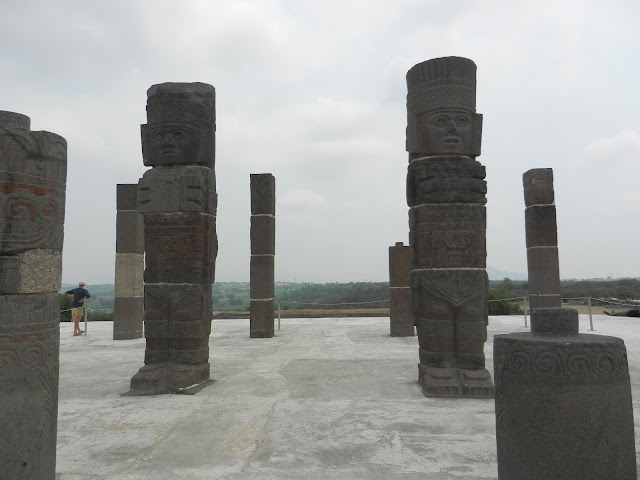The Templo Mayor was expanded on 7 different occasions, and on 5 additional occasions, only the main facade was expanded. So, as you walk through the site, you actually get to walk through all the layers. Each time they expanded, they completely covered the temple in a mix of mud and volcanic rock, and then literally built a bigger and taller temple on top of the old one. It was huge at the height of the empire (about 150 feet tall and much wider), but when the Spaniards arrived, they demolished most of it. Only the middle layer remains. (The top was destroyed, and the lower layers exist underground, where they can't be seen). When you first walk in, the temple doesn't seem to be particularly impressive at all.
As you continue, however, you'll see the well-preserved serpent and frog carvings. Serpents and frogs were very important in Aztec culture, both in architecture and in offerings. The frog altars were representative of the god "Tlaloc," or the god of rain and storms.
Continuing on, you'll come to a stone monolith of a dismembered Coyolxauhqui. The shortened version of the story goes like this: the goddess Coatlique got magically pregnant by putting a ball of feathers next to her womb. When her daughter, Coyolxauqui, found out, she conspired with her other siblings to kill their mother. However, the baby in Coatlicue's womb somehow spoke to her and told her that he would defend her. The baby, Huitzilopochtli, was born a grown man. He decapitated Coyolxauhqui, and later went on to become the god of war and sun.
 |
| Coyolxauhqui, queen of sibling rivalry. |
Later, we come to an area with two shrines. The shrine on the south side (right, in the picture below) was dedicated to Huitzilopochtli, god of war and sun. In the back, which unfortunately we can't see, there is an opening to enter the shrine. Inside, there was an image of the god. The main activity in this shrine was human sacrifice. People were sacrificed on a black tezontle sacrificial stone, and their hearts offered as divine food to the sun. (Yeeeesh, this culture was so brutal).
The shrine on the north side (left, in the picture above) was dedicated to Tlaloc, god of rain and storms. Huitzilopochtli and Tlaloc were the two patron deities of the Aztec/Mexica culture. Outside of the Tlaloc shrine, there is a polychrome sculpture of a chac mool bearing the attributes of Tlaloc and still retaining much of its original color. This chac mool dates back to 1350.
Next, we find the House of the Eagles. Only the elite were given access to this building, and this is where they held many of their religious ceremonies (meditation, prayer, penitence, offerings, etc.). Offering blood was likely a common activity here. This was another very well-preserved room, and you can see a lot of the original paint on the base-reliefs.
Also in the House of the Eagles, two statues representing Mictlantecutli (god of the underworld) were found. Yet another strange concept of this culture to me, only people who died a natural death went to the underworld. Dying in war or by sacrifice was the way people could reach the celestial levels. Perhaps unsurprisingly, then, is the fact that self-sacrifice was rather common. Now, we don't know for sure what going to the underworld entailed in Aztec/Mexica religion. Nowadays, we think of the underworld as the firey chasm of Hell. It may have been quite different for the Aztecs/Mexicas, but we really can only guess. What we do know is that the underworld had 9 levels, earth had one level, and there were 13 celestial levels. Beyond that, it's all just theory.
The next notable element would be the Tzompantli, or skull wall, which symbolized the region of the dead, Mictlampa. There were 240 stone skulls that made up this building, and the inside was for offerings.
After that, you'll come to the Red Temple, which was probably for leaving offerings. Some of the original red, white, yellow, and blue paint can still be seen.
The Templo Mayor used to be part of a large city, but it's all that's left after the Spaniards came and destroyed everything. In fact, the Metropolitan Cathedral in the Zocalo was literally built on top of other buildings of the city, including the ball court, the sun temple, and the temple of Ehecatl. Ruins of the city are still being found today! Not too long ago, when they were digging for the metro stations, another small offering temple was found, and it is displayed inside the Pino Suarez metro station, since they couldn't move or destroy it.
There is also a Templo Mayor museum, which takes a good 2 hours to tour. The best-preserved artifacts are housed in the museum, including offerings, statues, monoliths, weapons, decorations, explanatory figures and diagrams, and much more.
 |
| A representation of how the Templo Mayor was expanded |
 |
| Mictlantecutli--the god of the underworld. His liver is exposed, because the Aztecs/Mexicas believed the liver was the source of all evil in humans. |
 |
| An eagle-warrior statue |
 |
| There's that Coyolxauhqui again, in all her dismembered-ness. |
 |
| Tlaloc monolith |
 |
| A super well-preserved eagle sculpture |
 |
| An offering |
 |
| Another, much less creepy offering |
As brutal, gruesome, and gorey as the Aztec/Mexica culture could be, their history and culture were truly amazing, and so interesting to see and learn about. It's one of my favorite things about living in D.F.--actually seeing and visiting the things I'd only briefly learned about in school, and continuing to learn a lot more about Mexico's history. The Templo Mayor is especially great for those who aren't fluent in Spanish, because all of the signs have an English translation (a bit scarce in other archaelogical zones).












































